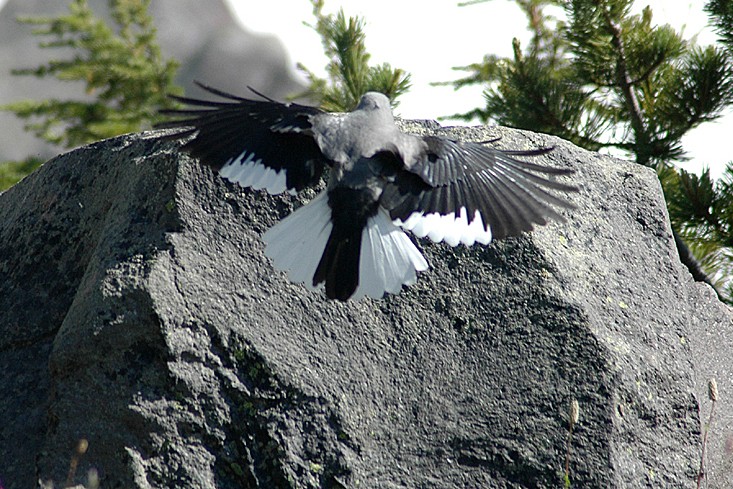Clark's Nutcracker
A species of Nutcrackers, Also known as Clark's Crow Scientific name : Nucifraga columbiana Genus : Nutcrackers
Clark's Nutcracker, A species of Nutcrackers
Also known as:
Clark's Crow
Botanical name: Nucifraga columbiana
Genus: Nutcrackers
Content
Description People often ask General Info
 Photo By Msulis , used under CC-BY-SA-2.5 /Cropped and compressed from original
Photo By Msulis , used under CC-BY-SA-2.5 /Cropped and compressed from original Description
Nucifraga columbiana can reach an average length of 28.8 cm (11.3 in). It is slightly smaller than its Eurasian relative the spotted nutcracker (N. caryocatactes). Most of its body has feathers that are ashy-grey and loose in texture. The wings and tail are black and white. The central tail feathers are black and the outer ones white. The bill, legs and feet are also black. The bill is long, stout, and cone-shaped. Measurements: Length: 10.6-11.8 in (27-30 cm) Weight: 3.7-5.7 oz (106-161 g) Wingspan: 24 in (61 cm) 
Size
32 cm (12.5 in)
Colors
Black
Gray
White
Life Expectancy
17 years
Nest Placement
Tree
Clutch Size
2 - 6 eggs
Incubation Period
1 brood
Number of Broods
18 days
Nestling Period
20 days
Feeding Habits
Clark's Nutcracker's primary diet consists of pine seeds, which they harvest using their sharp bill and store in sublingual pouches for later consumption. They cache seeds in the ground, exhibiting excellent spatial memory to retrieve them months later, aiding forest regeneration. Clark's Nutcracker also consumes insects, fruit, small mammals, birds, and carrion opportunistically.
Habitat
Clark's Nutcracker resides predominantly in open coniferous forests in western North America. Favored environmental conditions include altitudes of 900–3,900 meters in mountainous regions. They thrive in climates where whitebark, limber pine, and other pines mix with fir and spruce, with access to creeks and meadows. During post-breeding periods, clark's Nutcracker descends to lower elevations and may inhabit areas with Jeffrey pine, pinyon-juniper, and Douglas-fir, adjusting localities based on cone crop availability.
Nest Behavior
Clark's Nutcracker builds its nest within 5-8 days, with both sexes collecting materials. Egg-laying occurs once construction is complete. Both parents partake in nurturing the eggs and young, alternating between standing guard and foraging.
Nest Characteristics
Clark's Nutcracker's nest is usually located on the leeward side of conifer branches, constructed from materials like Douglas-fir, juniper, or incense cedar twigs. The nest is an 8-13 inch wide platform with a cup of wood pulp, lined with grass, bark, moss, or animal hair, and mineral soil.
Dite type
Omnivorous
People often ask
General Info
Feeding Habits
Bird food type

Black Oil Sunflower Seeds

Hulled Sunflower Seeds

Suet

Peanuts

Mealworms
Bird Feeder Type

Large Hopper

Platform

Ground
Behavior
Clark's Nutcracker exhibit a social nature, often found in small flocks engaging in raucous communication. Their flight is characterized by woodpecker-like undulation, a unique pattern of flapping and gliding. A typical day for clark's Nutcracker involves diligent collection and caching of pine seeds, key for winter sustenance. These birds are fierce competitors for food, not hesitating to displace peers from foraging sites. Monogamous pairing appears prevalent, with pairs maintaining long-term bonds illustrated by acrobatic courtship and joint territory defense. Nesting starts as early as January, timing offspring independence with peak caching season. Post-fledging, family groups merge into larger flocks, though solitary behavior is common during earnest seed retrieval or caching. Additionally, clark's Nutcracker often dominate multi-species foraging groups and will aggressively defend against larger predators. They also display playful behavior in challenging conditions and interact spiritedly with smaller raptors.
Distribution Area
This species is present in western North America from British Columbia and western Alberta in the north to Baja California and central New Mexico in the south. There is also a small isolated population on the peak of Cerro Potosí, elevation 3,700 metres (12,200 ft), in Nuevo León, northeast Mexico. It is mainly found in mountains at altitudes of 900–3,900 metres (3,000–12,900 ft) in conifer forest. It is not migratory except in the sense of moving back and forth locally between areas of higher and lower elevation. Outside the breeding season, it may wander extensively to lower altitudes and also further east as far as Illinois (and exceptionally, Pennsylvania), particularly following any cone crop failure in its normal areas. 
Species Status
Not globally threatened.
Scientific Classification
Phylum
Chordates Class
Birds Order
Perching birds Family
Crows and jays Genus
Nutcrackers Species
Clark's Nutcracker